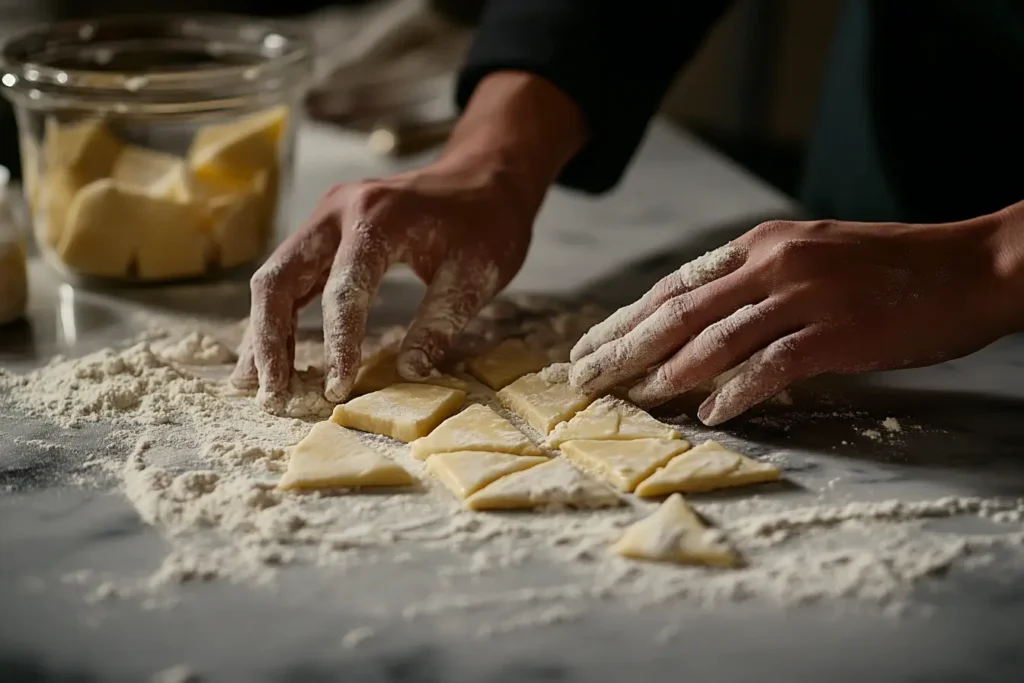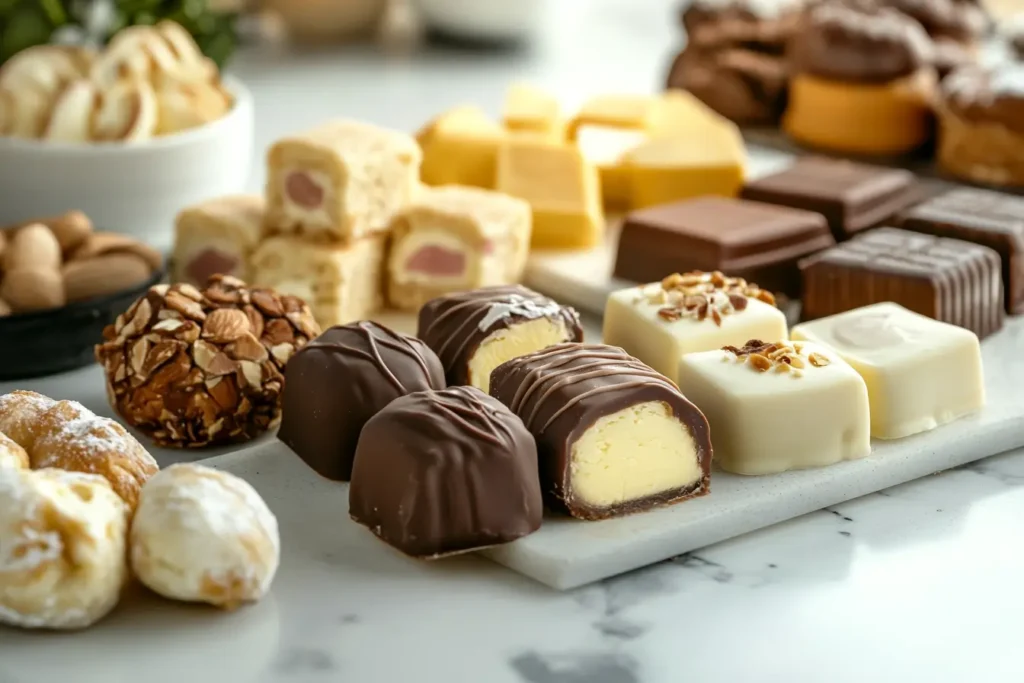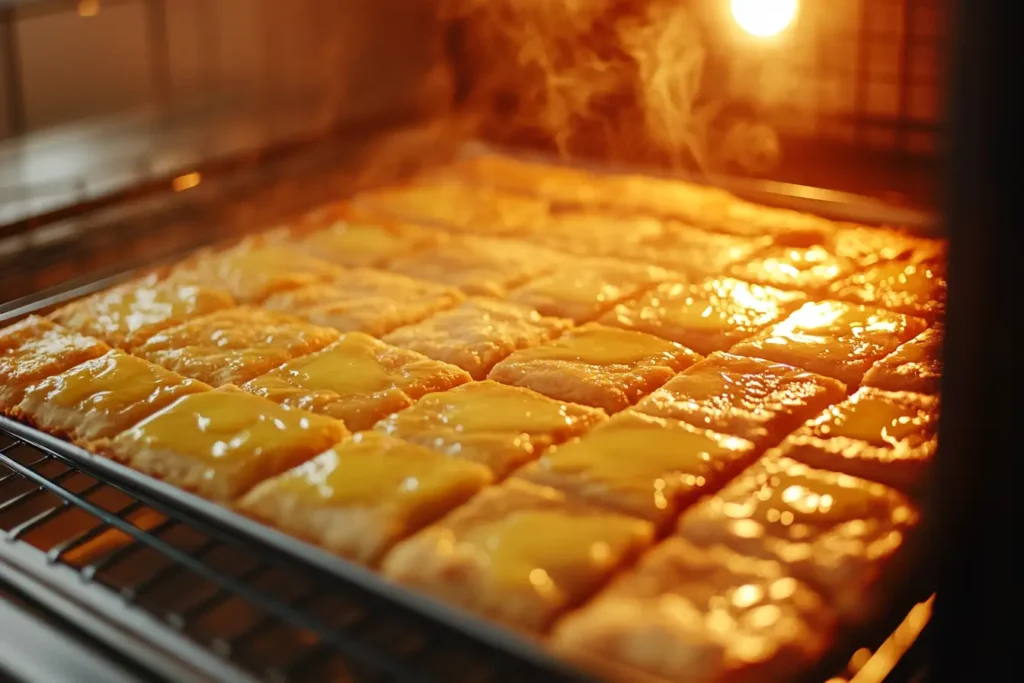Table of Contents
If you’ve ever strolled through a Swiss bakery, you’ve likely come across gipfeli a deliciously flaky, buttery pastry that’s similar to a croissant but uniquely Swiss. Unlike the classic French croissant, gipfeli has a denser texture and a slightly less buttery flavor, making it a staple in Swiss breakfasts.
In this guide, we’ll take you through an authentic gipfeli recipe, from selecting the right ingredients to mastering the folding technique that creates those irresistible, golden layers. Whether you prefer your gipfeli plain, sweet, or savory, we’ll explore different variations so you can customize this Swiss delicacy to your liking.
Along the way, we’ll share expert tips to help you avoid common mistakes, keep your gipfeli fresh, and achieve that perfect balance of crispiness and softness. Plus, we’ll answer frequently asked questions about this beloved pastry. So, if you’re ready to bring a taste of Switzerland into your kitchen, let’s get baking!
Introduction to Gipfeli
What is Gipfeli?
Gipfeli, often called the Swiss croissant, is a crescent-shaped pastry with a flaky exterior and a soft, slightly chewy interior. While it looks similar to its French counterpart, it differs in texture and butter content. Traditional gipfeli tend to be less buttery, slightly denser, and have a crispier crust than classic croissants. This makes them an ideal choice for a lighter yet satisfying breakfast pastry.
In Switzerland, gipfeli is a staple of morning coffee culture, often enjoyed with a cappuccino or hot chocolate. Whether bought fresh from a bakery or made at home, these pastries bring a touch of Swiss tradition to the table.
Gipfeli vs. Croissant – What’s the Difference?
Many people wonder: What is the difference between a croissant and a gipfeli? The answer lies in the ingredients and technique.
- Butter Content: Croissants use a high percentage of butter, creating an ultra-flaky texture. Gipfeli, on the other hand, contain less butter, making them drier and slightly firmer.
- Dough Composition: Croissants typically use yeasted laminated dough, while gipfeli can include a mix of milk and eggs, resulting in a more bread-like consistency.
- Texture and Taste: Gipfeli have a mildly sweet, crisp, and golden-brown crust, whereas croissants have a lighter, airier texture due to their intense lamination process.
The History and Popularity of Gipfeli in Switzerland
The origins of gipfeli can be traced back to European crescent-shaped pastries, dating as far back as the 17th century in Austria. Over time, Swiss bakers refined their own version, adapting the classic croissant to suit local tastes. The word “Gipfeli” itself comes from the Swiss German word for “peak” or “point,” referencing the pastry’s distinctive crescent shape.
Today, gipfeli is a beloved breakfast pastry in Switzerland, found in nearly every bakery and café across the country. Whether plain, filled with chocolate, almonds, or cheese, or paired with jam and butter, gipfeli remains a timeless Swiss delight.
Ingredients Needed for an Authentic Gipfeli Recipe
Making the perfect gipfeli starts with choosing high-quality ingredients. The right balance of flour, butter, and yeast ensures a pastry that is flaky on the outside yet soft and slightly chewy inside.
Essential Ingredients and Their Roles
Each ingredient in a gipfeli recipe serves a crucial purpose:
- Flour: Use bread flour or all-purpose flour for the best texture. Bread flour adds more structure, while all-purpose flour creates a lighter pastry.
- Butter: European-style butter with a high-fat content (82% or more) is ideal for a rich and flaky result.
- Yeast: Instant or active dry yeast helps create the light, airy layers.
- Milk: Adds moisture and gives gipfeli their signature golden-brown crust.
- Sugar and Salt: A small amount of sugar enhances flavor, while salt balances sweetness and improves dough elasticity.
- Eggs (Optional): Some versions of gipfeli include eggs for extra richness.
Best Flour, Butter, and Yeast for the Perfect Dough
For a truly authentic Swiss gipfeli, follow these tips:
- Choose unbleached, high-protein flour for a sturdy yet soft structure.
- Always use cold butter when laminating the dough—it prevents melting and ensures distinct flaky layers.
- If using active dry yeast, dissolve it in warm milk (not hot!) before adding to the dough for best activation.
Optional Additions: Sweet and Savory Variations
Want to elevate your gipfeli? Try these delicious variations:
- Sweet Fillings: Chocolate, almond paste, vanilla custard, or fruit jam.
- Savory Options: Cheese, ham, spinach, or even smoked salmon.
Now that we’ve covered the essential ingredients, let’s move on to the step-by-step guide to making gipfeli!
Step-by-Step Guide to Making Gipfeli

Step 1: Preparing the Dough – Kneading and Resting
To start, mix flour, sugar, yeast, and salt in a large bowl. Slowly add warm milk and knead the dough until it becomes smooth. Avoid over-kneading—too much gluten development makes the pastry tough instead of flaky.
Let the dough rest for 1-2 hours, covered with a damp towel. This allows the yeast to activate, making the dough easier to roll out.
Step 2: Folding and Layering for Flakiness
The secret to perfectly layered gipfeli is butter lamination. Here’s how:
- Roll out the dough into a thin rectangle.
- Place a cold butter slab in the center and fold the dough over it.
- Roll it out again, then fold into thirds like a letter. Repeat this 3–4 times, chilling between folds.
This process creates the delicate layers that make gipfeli so irresistibly flaky.
Step 3: Shaping the Classic Gipfeli Crescent
Once laminated, roll the dough into a large, thin sheet and cut triangular pieces. Roll each triangle from base to tip to create the signature crescent shape.
Make sure the tip of the dough is tucked underneath to prevent the gipfeli from unrolling during baking!
Step 4: Proofing – Why It’s Crucial for Light and Airy Pastries
Place the shaped gipfeli on a baking tray and let them proof for another hour. This allows the yeast to expand, giving the pastry its airy structure.
Tip: Avoid over-proofing, or the dough will collapse while baking!
Step 5: Baking to Perfection – Tips for a Golden, Flaky Crust
- Preheat your oven to 375°F (190°C).
- Lightly brush the gipfeli with egg wash for a shiny, golden crust.
- Bake for 15-18 minutes or until deep golden brown.
Once out of the oven, let them cool slightly before enjoying. Now you have homemade Swiss gipfeli—flaky, golden, and absolutely delicious!
Variations of the Traditional Gipfeli Recipe

One of the best things about the gipfeli recipe is how versatile it is. While the classic version is a simple buttery, flaky pastry, you can customize it with sweet or savory fillings to match your cravings. Here are some delicious variations to try at home!
Classic Butter Gipfeli vs. Whole Wheat and Vegan Options
The traditional Swiss butter gipfeli uses rich, high-fat butter, but there are other ways to enjoy this pastry:
- Whole Wheat Gipfeli: Substitute half the white flour with whole wheat flour for a nuttier, fiber-rich option. The texture will be slightly denser, but the flavor is still delightful.
- Vegan Gipfeli: Replace butter with vegan margarine and use plant-based milk instead of dairy. A touch of coconut oil can enhance flakiness.
Sweet Fillings: Chocolate, Almond, and Vanilla Custard
If you love sweet pastries, try filling your gipfeli with these delicious options before rolling them up:
- Chocolate Gipfeli: Add a small piece of dark chocolate to each triangle before rolling—when baked, it melts into a rich, gooey center.
- Almond Paste Filling: Spread a thin layer of almond paste or marzipan for a nutty, slightly sweet twist.
- Vanilla Custard: Spoon thick vanilla custard into the dough before rolling, making each bite creamy and decadent.
Savory Fillings: Ham, Cheese, and Spinach
Not a fan of sweet pastries? Try savory gipfeli for a perfect breakfast or snack!
- Ham and Cheese: Place a slice of Swiss cheese and ham inside before rolling—ideal for a hearty, protein-packed pastry.
- Spinach and Feta: Mix cooked spinach and crumbled feta cheese for a Mediterranean-inspired version.
- Smoked Salmon and Cream Cheese: Spread a thin layer of cream cheese and add a small piece of smoked salmon before rolling.
Experimenting with different flavors and textures makes the gipfeli recipe even more exciting. Whether you prefer it sweet or savory, there’s a version for everyone!
Expert Tips for Perfect Gipfeli Every Time

Baking the perfect gipfeli recipe requires patience, technique, and the right ingredients. To help you master this Swiss pastry, here are some expert tips for the best results.
The Secret to a Perfectly Flaky and Buttery Gipfeli
- Use cold butter: Keeping the butter cold while laminating prevents it from melting into the dough, ensuring distinct, flaky layers.
- Don’t rush the resting time: Letting the dough rest in the fridge between folds helps it develop flavor and texture.
- Preheat the oven properly: A hot oven (375°F/190°C) ensures the butter steams inside the dough, creating a crispy, golden crust.
Common Mistakes and How to Avoid Them
- Over-kneading the dough: If the dough is too elastic, it becomes hard to roll out. Knead until just combined.
- Skipping the final proofing step: Letting gipfeli rest before baking creates a light, airy texture—don’t skip this!
- Using too much flour when rolling: Extra flour can dry out the dough, making it harder to achieve soft, flaky layers.
Storage and Reheating Tips for Freshness
Want to keep your homemade gipfeli fresh? Here’s how:
- Room Temperature: Store in an airtight container for up to 2 days.
- Freezing: Gipfeli freeze well! Wrap them in plastic and freeze for up to 3 months. Reheat in an oven at 300°F (150°C) for 5-7 minutes.
- Reheating Leftovers: Avoid microwaving—it makes them soggy! Instead, toast in the oven for a crispy texture.
With these expert tips, you’ll always have perfect, bakery-quality gipfeli at home!
ParServing Suggestions and Pairings

Once you’ve mastered the gipfeli recipe, the next step is serving it the Swiss way! Whether you prefer a simple breakfast or an indulgent treat, gipfeli pairs well with a variety of flavors and drinks.
Traditional Swiss Breakfast: How Gipfeli is Served
In Switzerland, gipfeli is typically enjoyed fresh from the bakery with butter and jam. A light dusting of powdered sugar adds a delicate sweetness.
For a hearty breakfast, Swiss locals sometimes split a warm gipfeli and fill it with Nutella or honey. On weekends, it’s common to serve gipfeli with a platter of cheese, cured meats, and fresh fruit.
Beverage Pairings: Coffee, Tea, and Swiss Hot Chocolate
A buttery, flaky gipfeli tastes even better with the right drink. Here are some classic pairings:
- Swiss Coffee (Café Crème): A creamy espresso drink that balances the richness of gipfeli.
- Black Tea with Lemon: The light acidity of lemon cuts through the pastry’s buttery texture.
- Swiss Hot Chocolate: Thick, creamy, and rich—perfect for dipping your gipfeli!
However you choose to enjoy it, serving your homemade gipfeli with a warm drink makes for an authentic Swiss breakfast experience.
Frequently Asked Questions (FAQ)
Still have questions about the gipfeli recipe? Here are answers to some of the most common queries!
What is the difference between a croissant and a gipfeli?
Although similar, gipfeli is denser and less buttery than a French croissant. Croissants have a lighter, airier texture due to a higher butter content and intense lamination process. Gipfeli also tends to have a crispier crust, making it a unique Swiss treat.
What is the secret to a good croissant (or Gipfeli)?
The key to a perfect gipfeli lies in lamination, proofing, and baking temperature:
Use high-quality butter for rich flavor.
Allow the dough to rest properly between folds for distinct flaky layers.
Preheat the oven correctly to ensure a crispy, golden-brown crust.
What ingredients are in a croissant or Gipfeli?
A classic gipfeli recipe includes:
Flour (bread or all-purpose)
Butter (for layering)
Yeast (to make the dough rise)
Milk (adds richness)
Sugar & Salt (for balance)
Can I freeze Gipfeli dough for later use?
Yes! You can freeze raw or baked gipfeli:
For unbaked dough: Shape the gipfeli, then freeze on a baking sheet. Once solid, store in an airtight container for up to 3 months. When ready to bake, allow them to thaw and proof before putting them in the oven.
For baked gipfeli: Freeze in a sealed bag, then reheat in the oven at 300°F (150°C) for 5-7 minutes to restore crispiness.
Now that you have all the answers, you’re ready to bake authentic Swiss gipfeli anytime! 🥐
Print
Authentic Swiss Gipfeli Recipe – Flaky & Buttery Pastry
- Total Time: 3 hours 15 minutes
- Yield: 12 Gipfeli 1x
Description
Make this authentic Gipfeli recipe at home and enjoy a buttery, flaky Swiss pastry. Perfect for breakfast, this homemade Gipfeli is golden and crisp!
Ingredients
- 3 ½ cups (450g) bread flour (or all-purpose flour)
- 1 ¼ tsp salt
- 3 tbsp sugar
- 1 tbsp instant yeast (or active dry yeast)
- 1 cup (240ml) warm milk (not hot!)
- 10 tbsp (140g) cold butter (European-style, 82% fat)
- 1 egg yolk + 1 tbsp milk (for egg wash)
Instructions
Step 1: Prepare the Dough
- In a large mixing bowl, combine flour, salt, sugar, and yeast.
- Gradually add warm milk and knead for 8-10 minutes, until smooth.
- Cover and let rest for 1 hour in a warm place.
Step 2: Roll and Layer the Dough
- Roll out the dough into a large rectangle on a floured surface.
- Place cold butter in the center and fold the dough over it.
- Roll it out again, then fold into thirds like a letter. Repeat 3-4 times, chilling for 20 minutes between folds.
Step 3: Shape the Gipfeli
- Roll out the dough into a thin sheet and cut into triangles.
- Roll each triangle from the base to the tip, forming a crescent shape.
- Place on a baking tray, cover, and let proof for 1 hour.
Step 4: Bake the Gipfeli
- Preheat the oven to 375°F (190°C).
- Brush each gipfeli with egg wash for a golden crust.
- Bake for 15-18 minutes, until deep golden brown.
Notes
✅ For vegan Gipfeli, replace butter with vegan margarine and use plant-based milk.
✅ Want sweet fillings? Add chocolate, almond paste, or vanilla custard before rolling.
✅ For savory Gipfeli, try ham and cheese or spinach and feta!
✅ Storage: Keep in an airtight container for 2 days or freeze for up to 3 months.
- Prep Time: 45 minutes
- Cook Time: 15-18 minutes
- Category: Breakfast
- Cuisine: 🇨🇭 Swiss
Nutrition
- Calories: 220 kcal
- Sugar: 3g
- Fat: 10g
- Carbohydrates: 30g
- Protein: 5g
Keywords: Gipfeli recipe, Swiss croissant, flaky breakfast pastry, homemade Gipfeli, Swiss bakery pastry, easy Gipfeli recipe, buttery Swiss pastry

